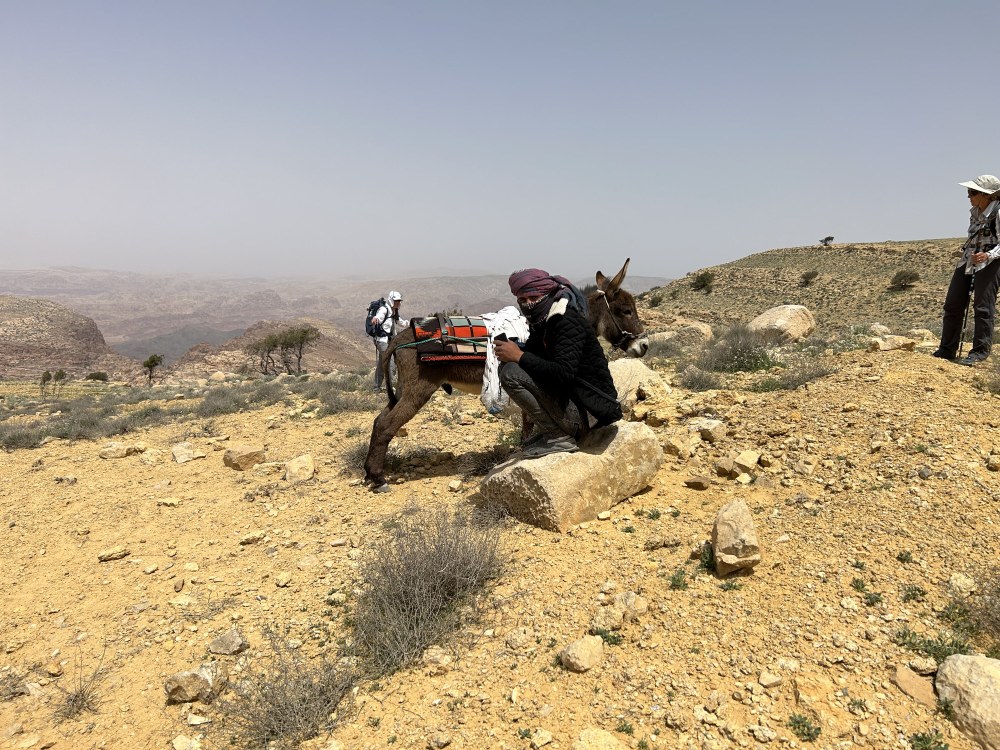
Toiling up a dry mountain shoulder in desert heat, I briefly question why I signed on to hike the highlights of Jordan’s national trail on a Mountaineers Global Adventures trip. Then I crest the shoulder of Jordan’s Grand Canyon and see the Dead Sea glimmering in the hot haze. I remember that this place has history. Jordan encompasses the biblical land of Moab. Nearby Mt. Nebo, above the Dead Sea, is where Moses saw the Promised Land. To the south, where we’re headed, lies Edom, abled site of Sodom and Gomorrah. Visiting the desiccated salt flats around the Dead Sea, I can see these stories come to life.
Running north to south from Syria to Aqaba on the Red Sea, the unmarked Jordan Trail exists as GPS waypoints. A website provides maps and descriptions of the lightly-worn shepherd’s path and connects travelers with outfitters and guides. Greener in the north, where olive groves are common, the terrain dries out where Bedouins graze goat herds in the middle of the country. The trail crosses true desert as it reaches the famed ruins of Petra on its way to the extension of the Arabian desert known as Wadi Rum.
Trekking is new in Jordan. Our volunteer trip organizer worked with a Jordanian outfitter to plan the trip, making arrangements with Bedouin tribes to host us and to provide a guide from the local tribe who knew the route and the water sources. To help along the trail, the outfitter recruited Aboud Hijazi, an incredibly experienced traveler, group leader, and trailblazer for the new outdoor industry in modern Jordan.
Wadi Mujib, Jordan’s Grand Canyon
A great declivity known as Wadi Mujib runs from Jordan’s central highlands to the Dead Sea. To reach the canyon, we climb 3,000 feet up from Wadi Hidan and then drop down the other side into Wadi Mujib. A dirt track at the bottom reaches Bedouin encampments, where we camp.
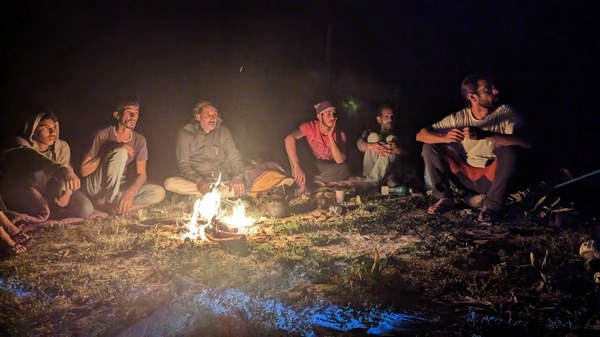 The Bedouin, who welcome us into their camps.
The Bedouin, who welcome us into their camps.
The Bedouins set up tents for us and cook a fine meal of rice and lamb, which we enjoy under the stars. Our camp each night centers around a large Bedouin tent used for lounging and eating. We sleep in outlying small camp tents under heavy woolen blankets. The Bedouin communal tent is constructed of heavy woolen cloth erected on local stakes and tensioned with thick cords. Meals are cooked over a fire, which the Bedouins light on a moment’s notice using the scant nearby brush. The men who made our camp make it clear that even though we are paying them, in their tradition we are their guests in every sense of the word.
As it is Ramadan, our hosts have not eaten all day. They wait for us to eat before breaking their fast with traditional Iftar (end of fast) dishes such as Labneh (aged goat yogurt) and dates. They share their Iftar with us as well.
Getting an early start the next morning, hoping to reach high ground before the heat of the day, we toil up almost 4,000 feet to a wide plateau covered with flowery meadows. We document over fifty species such as indigenous tulips and black iris.
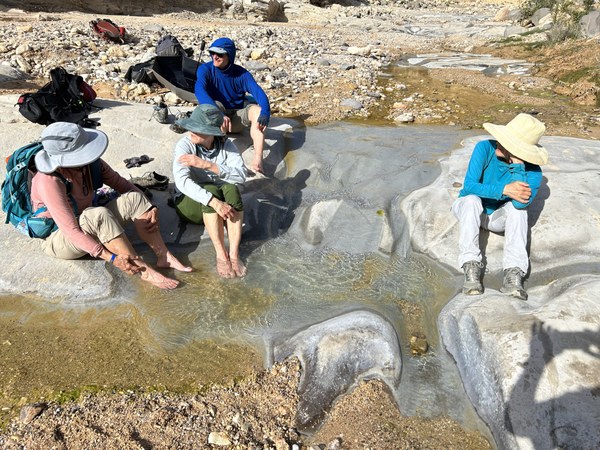 A rare spring-fed stream providing relief to our desert-sore feet.
A rare spring-fed stream providing relief to our desert-sore feet.
From Dana to Petra
Over the next four days, we walk through the Dana Biosphere Reserve, Jordan’s largest natural area, and on to Petra, the fabled 2,000-year-old City of Tombs. Our trek from Dana to Petra passes through rugged mountains above Jordan’s great rift valley. Each day we climb 3,000-4,000 feet from dry, rocky valleys at the bottom to flowery meadows at higher elevations.
We pass petroglyphs (rock carvings). Some are prehistoric while others are tens to hundreds of years old, maybe representing the creative efforts of idle shepherds. We look for dinosaur tracks that have recently been discovered. Walking up a dry creek bed through layers of sandstone, we soon find obvious fossil footprints of a small to medium-sized three-toed animal, a hundred-million-year-old carnivore called a theropod that once roamed the shoreline of an ancient sea.
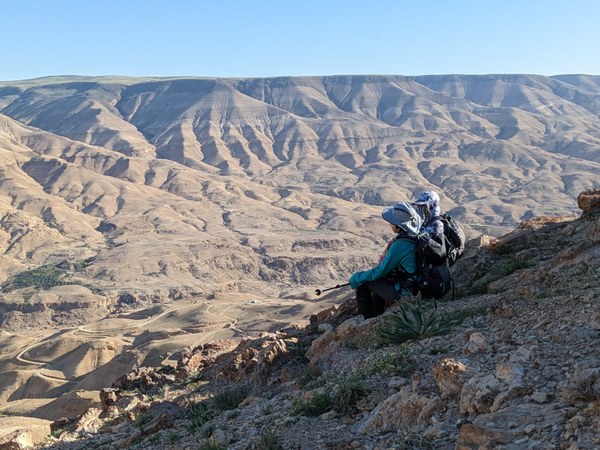 Wadi Mujib, Jordan's Grand Canyon, which runs from the Central Highlands to the Dead Sea.
Wadi Mujib, Jordan's Grand Canyon, which runs from the Central Highlands to the Dead Sea.
After a particularly relentless and tedious descent, we seek the scant shade at the bottom. Following the wadi the last mile to our camping spot, we cross a rare running stream. We are all eager to take off our boots and put them in the cool stream.
Sharing camp with the Bedouins helps us learn about their culture and life. Modern Bedouins own pickup trucks and cell phones, but they still follow the herds. Our guide is a good example of the old world blended with the new. When not guiding tourists, he works as a shepherd. He also attends college.
Bedouin women share in the work of tending the flocks, but we only catch brief glimpses of the women who live with our hosts – their religion and culture requires great modesty around strangers. Throughout our journey, we see women skittering out of view or darting modestly into their tents.
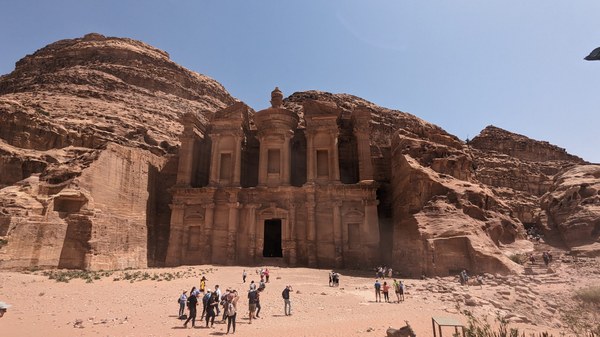 Petra, City of the Dead.
Petra, City of the Dead.
With six days of hiking behind us, we shift gears, visiting the world heritage site of Petra and the spectacular desert known as Wadi Rum, snorkeling in the Red Sea, and bobbing 1,000 feet below sea level in the hypersaline Dead Sea. All of this — the trek in the desert, meeting and camping with Bedouins, and visiting the cities and sites of modern Jordan — was possible because of the efforts of volunteers organizing these activities through The Mountaineers. Rich with beauty, history, and hospitality, trekking the Jordan Trail is a trip I will never forget.
Global Adventures is The Mountaineers adventure travel program and currently offers a wide range of domestic and international activities suitable for all types of adventure seekers, such as trekking, backpacking, day hiking, and cross country skiing. We are currently seeking more trip leaders and planning new trips beyond the Pacific Northwest. Learn more and sign up at mountaineers.org/globaladventures.
This article originally appeared in our fall 2023 issue of Mountaineer magazine. To view the original article in magazine form and read more stories from our publication, visit our magazine archive.
 Charles Bookman
Charles Bookman